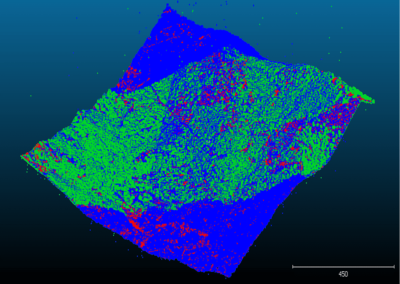
A new paper in the journal Land presents a new data recording and processing workflow that improves the detection and analysis of microtopographical archaeological features.
LiDAR-derived digital terrain models (DTM) have, during the last years, become an essential tool in Landscape Archaeology, where the use of complex visualisation algorithms has revealed important geomorphological and cultural information.
PhD researcher at the GIAP research group Iban Berganzo-Besga, led by Dr. Hèctor A. Orengo (ICAC), in collaboration with Dr. Maria Carme Belarte (ICREA-ICAC) and Dr. Joan Canela (ICAC), has shown the potential of multitemporal LiDAR-derived DTM for the detection of subtle archaeological features under perennial dense forest.
The workflow presented in the paper at Land provides a way to co-register and filter several point clouds to increase the resolution of a DTM and, by doing so, improve the detection of subtle topographic features even in complex areas were perennial forest and shrubs combine with abrupt slopes. The employed data included all ICGC’s coverages (both 2008-2011 and 2016-2017) and purposedly commissioned LiDAR coverage, also from the ICGC. This allowed the authors to obtain a very high resolution co-registered and classified point cloud with an average density of 6-9 points/m2.

The new workflow has been able to detect th fortified walls of six Iberian Iron Age sites, located in Catalonia.
To test this approach, researchers have produced a series of DTM models using multitemporal LiDAR data from a series of Iberian Iron Age settlements from which architectural remains were detected on site but not thoroughly mapped. They all are in low mountain forested areas. The sites under investigation correspond to the settlements of Burriac (Cabrera de Mar, Maresme), Castell Barri (Calonge, Baix Empordà), Puig d’en Rovira (La Creueta de Quart, Girona), Puig Castell (Cànoves i Samalús, Vallès Oriental), Sant Miquel (Vallromanes/Montornès, Vallès Oriental), and Torre Roja (Caldes de Montbui, Vallès Oriental).
The paper published at Land has shown how the combined use of multitemporal lidar datasets and multiscale approaches to micro-relief visualisation can improve the visualisation of subtle archaeological remains present as micro-reliefs in the ground surface even in complex environments such as forested mountain Mediterranean areas.
This method has the potential to radically improve archaeological survey and the detection and analysis of microtopographic archaeological features.
Compared to previous research, the workflow shows notable improvements in the visualisation of the wall structures. The delimitation of the walls and the potential extension of the archaeological sites provides important new data as:
- It will allow to estimate the potential population and hierarchies between sites;
- It will allow the development of conscientious excavation planning, which can now focus on intramural areas and not waste efforts in potentially uninhabited sectors;
- . It will allow a much more informed heritage protection measures, which will be able to take into account the whole extension of the sites and not just the small sector where remains have been detected.
More importantly, the workflow has the potential to be employed for the combination and filtering of not just lidar but also different types of legacy point data such as DGPS, total, station or photogrammetry-derived point clouds. As such it provides an important new basis for the integration of data, which up to know had rarely been combined, that can be used for the development of accurate high-resolution DTMs.
Read the paper in open access:
Potential of Multitemporal LiDAR for the Detection of Subtle Archaeological Features under Perennial Dense Forest, Iban Berganzo-Besga, Hèctor A. Orengo, Joan Canela, Maria Carme Belarte, Land 2022, 11(11), 1964 (https://doi.org/10.3390/land11111964 – registering DOI).
Bibliography
Belarte, M. C.; Canela, J.; Orengo, H. A.; Berganzo-Besga, I. “Using LiDAR to detect architectural features in urban sites in the coast of Northern Iberia (6th – 3rd centuries BC). Preliminary results”, en: Belarte, M. C.; Noguera, J.; Plana-Mallart, R.; Sanmartí, J.; (eds.), Urbanización en Iberia y la Galia Mediterránea en el Primer Milenio aC, TRAMA 7, ICAC, Tarragona, 2020, vol. 1, p. 137-148 (http://hdl.handle.net/2072/417717).
Berganzo-Besga, I.; Orengo, H. A.; Lumbreras, F.; Carrero-Pazos, M.; Fuente, J.; Vilas-Estévez, B. “Hybrid MSRM-Based Deep Learning and Multitemporal Sentinel 2-Based Machine Learning Algorithm Detects Near 10k Archaeological Tumuli in North-Western Iberia”, Remote Sens 13, 2021, 4181 (https://doi.org/10.3390/rs13204181).
Guyot, A.; Lennon, M.; Hubert-Moy, L. “Objective comparison of relief visualization techniques with deep CNN for archaeology”, Archaeol. Sci. Rep 38, 392, 2021, 103027 (https://doi.org/10.1016/j.jasrep.2021.103027).
Orengo, H. A.; Petrie, C. A. “Multi-scale relief model (MSRM): a new algorithm for the visualization of subtle topographic change 390 of variable size in digital elevation models”, Earth Surf. Process. Landf 43, 2018, 1361-1369 (https://doi.org/10.1002/esp.4317).
Funding
This research was funded by the Spanish Ministry of Economy and Competitiveness, grant number HAR2015-67946-C2-2-P.





